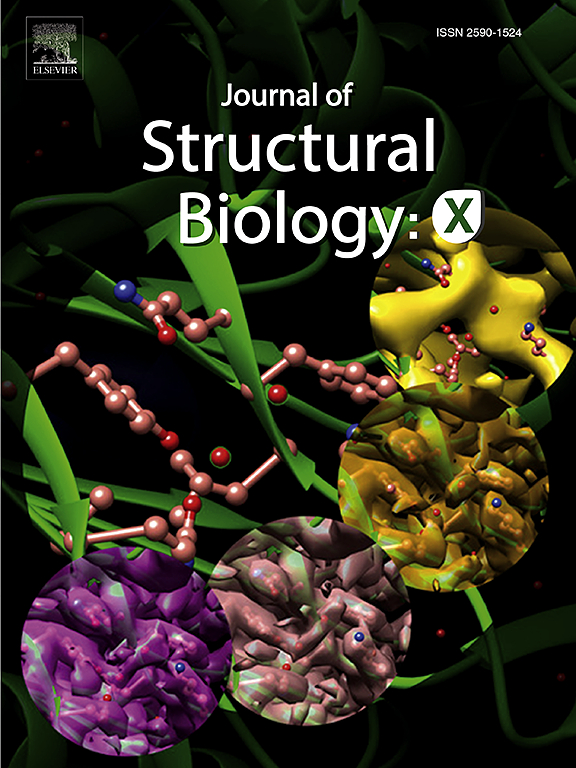The product specificities of terpinolene synthase, from cannabis sativa, reveals the plasticity of the terpene synthase active site
IF 2.7
3区 生物学
Q3 BIOCHEMISTRY & MOLECULAR BIOLOGY
引用次数: 0
Abstract
Cannabis sativa is a high-value plant renowned for its diverse chemical composition and abundant terpene content, contributing to its unique aroma, flavour, and therapeutic effects. Terpenes significantly influence consumer preference for C. sativa products, driving scientific interest in optimising terpene expression profiles and shaping the selective breeding of terpene profiles in C. sativa cultivars. In particular, the monoterpene, terpinolene, is influential in defining the sensory and therapeutic qualities of many C. sativa strains due to its woody, citrus-like aroma. Here we report the 2.5 Å resolution crystal structure of terpinolene synthase (CsTOS) from C. sativa in its apo form. The structure exhibits the class I monoterpene synthase fold with an open active site conformation. Using site-directed mutagenesis, we identified H618 as a key residues in determining product specificity. Substituting H618 with charged residues resulted in the preferential formation of limonene over terpinolene, highlighting its critical role in stabilising the substrate intermediate. Additionally, novel mutations uncovered an extended epistatic network of residues within 5 Å of the active site, spanning the α-helical bundle of the terpene synthase fold. These interactions contribute to monoterpene formation by modulating substrate positioning and catalytic activity. These insights advance our understanding of monoterpene biosynthesis and enable the targeted engineering of terpene synthases for customised terpene production, offering significant potential for the C. sativa industry.

从大麻中提取的萜烯合成酶的产物特异性揭示了萜烯合成酶活性位点的可塑性
大麻是一种高价值植物,以其多样化的化学成分和丰富的萜烯含量而闻名,有助于其独特的香气,风味和治疗效果。萜烯显著影响着消费者对sativa产品的偏好,推动了优化萜烯表达谱和形成sativa品种萜烯谱选择性育种的科学兴趣。特别是,单萜烯,萜烯,由于其木质的,柑橘般的香气,在定义许多sativa菌株的感官和治疗品质方面具有影响力。在这里,我们报道了苜蓿中载脂蛋白形式的萜烯合成酶(CsTOS)的2.5 Å分辨率晶体结构。该结构呈ⅰ类单萜合成酶折叠,具有开放的活性位点构象。使用定点诱变,我们确定H618是决定产品特异性的关键残基。用带电荷的残基取代H618导致柠檬烯优先形成而不是萜烯,突出了柠檬烯在稳定底物中间体中的关键作用。此外,新的突变揭示了活性位点5 Å内一个扩展的上位网络,跨越了萜烯合成酶折叠的α-螺旋束。这些相互作用通过调节底物定位和催化活性来促进单萜烯的形成。这些见解促进了我们对单萜烯生物合成的理解,并使萜烯合成酶的针对性工程能够用于定制萜烯生产,为芥蓝产业提供了巨大的潜力。
本文章由计算机程序翻译,如有差异,请以英文原文为准。
求助全文
约1分钟内获得全文
求助全文
来源期刊

Journal of structural biology
生物-生化与分子生物学
CiteScore
6.30
自引率
3.30%
发文量
88
审稿时长
65 days
期刊介绍:
Journal of Structural Biology (JSB) has an open access mirror journal, the Journal of Structural Biology: X (JSBX), sharing the same aims and scope, editorial team, submission system and rigorous peer review. Since both journals share the same editorial system, you may submit your manuscript via either journal homepage. You will be prompted during submission (and revision) to choose in which to publish your article. The editors and reviewers are not aware of the choice you made until the article has been published online. JSB and JSBX publish papers dealing with the structural analysis of living material at every level of organization by all methods that lead to an understanding of biological function in terms of molecular and supermolecular structure.
Techniques covered include:
• Light microscopy including confocal microscopy
• All types of electron microscopy
• X-ray diffraction
• Nuclear magnetic resonance
• Scanning force microscopy, scanning probe microscopy, and tunneling microscopy
• Digital image processing
• Computational insights into structure
 求助内容:
求助内容: 应助结果提醒方式:
应助结果提醒方式:


